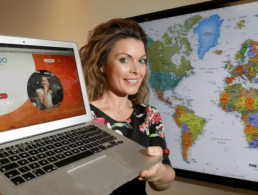Dr Sarah Kieran and Dr Sinéad Burke examine what it means to have a ‘SMART’ workplace design and how employers can keep their best talent with the right tools in place.
As the intersection between physical and digital, human and machine intensifies, the pandemic has been a much-needed catalyst for change in the world of work.
The need to pivot workplaces into people’s homes, in tandem with a wave of social reflection during this period, has brought critical questions about the way we work to the fore.
Organisations are compelled to address fundamental workplace trends that struggled to gain traction prior to the pandemic.
These trends, perceived by some organisations as opportunities and others as challenges, sit at the critical nexus between human and machine. Digital transformation drives the automation of work tasks, displacing some, replacing others and creating organisational requirements for upskilling or reskilling along the way.
However, digital transformation also transforms the context of work, altering business networks, critical relationships and the time and place of work through the emergence of virtual, hybrid and flexible working practices.
For organisational shareholders, the benefits of digital transformation are clear. The transformation process might be arduous, requiring substantial redesign of operating models and workforces, but it leads to significant increases in operational efficiencies and reductions in operational costs.
Furthermore, digital transformation can be market-shaping, leading to completely new customer propositions.
Toyota has recently introduced a subscription service for its remote key fob, surely heralding a new direction in car manufacturing. Dell Technologies is going all the way, pronouncing a strategic re-focus by transitioning customers from traditional consumers into ‘on-demand service-users’.
Organisations cannot ignore the impact of such transformation on the way jobs are designed and the way people are led, managed and developed.
They must address its impact on the nature of work and they must ensure technology is being leveraged as much for their people as for the shareholder and customer.
Technology and the nature of work
The impact of technology on the nature of work can only truly be considered from a resource-based view of the organisation. This strategic perspective holds that employees are an organisation’s most valued asset and its single greatest differentiator in the marketplace.
The SMART work design, developed by Sharon Parker and Gudela Grote, outlines how organisations need to design jobs that meet five key requirements.
They need to offer people stimulating work, comprising a variety of tasks and problems to solve, and skills to apply or develop.
They also need to develop mastery opportunities by providing clear roles, regular, critical feedback and a sense of purpose.
Jobs also need to have agency, achieved through people’s ability to control their own work, how it is conducted, scheduled and how decisions are made.
Relational experiences are central to work so positive supervisory or peer support and a sense of social worth are vital.
Finally, as we have seen through the pandemic, organisations should only place tolerable demands on their people, ensuring they have the space, time and skills to do their job well, encounter low levels of conflict and emotional demands and ensure the monitoring of their work is not excessive.
Organisations that view their people as commodities, seek to retain the status quo or hesitate to address deficiencies in their job design will struggle through digital transformation and fail to realise the potential of their market strategies.
However, organisations that believe in people as assets will design the work around these people to ensure the most sustainable business outcomes.
The book Invisible Women: Exposing Data Bias in a World Designed for Men by Caroline Criado Perez outlines how data gaps relating to gender identity, race and disability impact on everything from workplaces and technology design to healthcare and public life.
Relying on imperfect technology developed using imperfect data while ignoring the inherent value people bring to the process of work will be detrimental.
Technology and where we work
It is almost 20 years since the advent of 3G data, which allowed for greater connectivity and mobility around how we do our work.
As technologies have advanced so too have the tools for working across time and place, such as online meeting platforms and project management applications (Zoom, Microsoft Teams, Slack, Basecamp etc).
However, these tools have largely only been applied to meet the needs of the organisation. Where it makes financial sense to develop allied business models within strategic sector clusters and/or across geographic regions, organisations have embraced the concept of the virtual project team.
There is widespread evidence that many organisations have not fully promoted virtual work practices for the benefit of the people who do the work. So, for years it has been OK to come into the office and get online with the United States or India, but not always acceptable to stay at home and get online with the office.
Historically, traditional approaches prevail with managers who like to see ‘people at work’. However, the pandemic has challenged that mindset. Where the work tasks allowed, people were able to maintain their work quality and output from home so the management argument that ‘it could not be done’ was irrevocably undone.
Now we sit at a critical juncture as organisations grapple with the post-pandemic return to workplace, social and/or legislative changes around the right to request remote work, and lead indicators of a ‘great resignation’.
‘Maybe the solution is simpler than we think – allow people take the lead’
The work-life balance and wellbeing narratives have been around for a long while, but the common solution has been to offer supports to people who are overwhelmed with the pace of work (anyone for lunchtime yoga?) rather than step back and see how the time and place of work could be better managed.
The virtual work tools available today provide many innovative and exciting opportunities for people to engage in work individually and collectively. While there is merit in bringing people together in person to work, this collective socially dynamic work needs to be meaningful and done with purpose rather than just because we want to see people ‘at work’.
Interestingly, wasting collective/social interactions in the workplace is nothing new. Death by PowerPoint, pre-meetings for the meeting, meetings for meetings’ sake are by no means a new phenomenon. Perhaps, by allowing people shape the way they engage with their work, these issues will be consigned to the past.
As of yet, we don’t have a SMART design tool to help us figure this one out, but figure it out we must as younger generations are challenging the aforementioned, jaded narrative of work-life balance.
Maybe the solution is simpler than we think – allow people take the lead. Create the SMART jobs, which give people the scope to construct the way they need to work independently and collectively, and allow new work structures to emerge organically. It will be messy, but the most sustainable change always is!
By Dr Sarah Kieran and Dr Sinéad Burke
Dr Sarah Kieran is a lecturer in the Department of Work and Employment Studies at University of Limerick. Dr Sinéad Burke is a manager for UL@Work, a range of digital-led programmes at University of Limerick.
Don’t miss out on the knowledge you need to succeed. Sign up for the Daily Brief, Silicon Republic’s digest of need-to-know sci-tech news.




